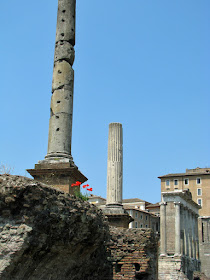Our tour guide disagreed and is of the opinion that the Colosseum is the center. He stated is shows the difference between the Greeks and the Romans. The Romans liked to enjoy life, thus the Flavian Amphitheater was their most important building. The Greeks, he said, were much more serious and thus the Acropolis (and the Parthenon specifically) was their most imporant building.
I haven't fact-checked him, but he also stated that for centuries the Forum was abandoned and was actually filled with sand. It wasn't until recent centuries that it has been re-excavated.
Here we are approaching the Roman Forum from Palatine Hill. Little did we know we would be passing Weird Al Yankovic on this pathway.
This is the Temple of Antoninus and Faustina, undergoing restoration. It was erected by Emporer Antonius Pius in 141 AD and dedicated to his wife, Faustina. It was converted to the Church of San Lorenzo in the 11th century and rebuilt in 1601.
I was disappointed that it was covered in scaffolding, but from pics on the web it just looks like a church with Roman columns out front.
We spent a considerable amount of time here in the House of the Vestal Virgins, probably because there were places to sit.
After 30 years, they were free to marry whoever they wanted though few choseto leave their highly respected role in very luxurious surroundings. Besides, the average Roman lifespan back then was mid-40s. These women would have been about 40 by the time their commitment was complete.
The Vestals were "volunteered" by their families and had to be between 6 and 10, free of defects, born to two free-born Roman residents.
As one would imagine, it became progressively more difficult to find families who would volunteer their daughters. Therefore, eventually plebian girls were admitted, and finally daughters of freed men.
Hair caught mid-flip.
At long last, we caught our breath...
.
...and carried onThe original Via Sacra, complete with Roman cart wheel paths in the stone.
The Temple of Antoninus and Faustina from a different angle.
Red poppies!
By this point, it was around 12:30 and we were all beat and exhausted. Lucky for us, our hotel was virtually across the street.
More cart wheel ruts.
As the other tourists were rolling in from their late sleep, we were wrapping up and heading back to our room.




























No comments:
Post a Comment